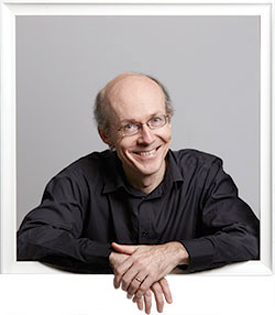by Daniel Hathaway
 “Rise up, my love, my fair one, my dove, and come away. For, lo, the winter is past, the rain is over and gone; The flowers appear on the earth; the time of the singing of birds is come, and the voice of the turtle is heard in our land; The fig tree putteth forth her green figs, and the vines with the tender grape give a good smell.”
“Rise up, my love, my fair one, my dove, and come away. For, lo, the winter is past, the rain is over and gone; The flowers appear on the earth; the time of the singing of birds is come, and the voice of the turtle is heard in our land; The fig tree putteth forth her green figs, and the vines with the tender grape give a good smell.”
Those are welcome sentiments as we Northeast Ohioans continue to slide across the ice, slog through the drifts and wade through muddy puddles, but where do they come from? They’re words from the Biblical Song of Songs as set by the Vatican composer Giovanni Pierluigi da Palestrina in the late 16th century. Surge, propera amica mea is only one of twenty choral pieces from medieval times to the twenty-first century based on The Song of Songs that will be featured in Quire Cleveland’s free weekend concerts on Friday, February 27 at 7:30 at St. John’s Cathedral in Cleveland and on Saturday, February 28 at 7:30 at St. Bernard’s Church in Akron.
Invited to guest conduct Quire by Ross Duffin and Beverly Simmons, who have known the Canadian conductor for years, David Fallis suggested a few different repertoire ideas. “We cooked the Song of Songs program up together,” Fallis said in a telephone conversation. “I did a similar program a few years ago when I had a community choir in Toronto. It was part of a week-long mini festival based on The Song of Songs developed in conjunction with a Jewish Community Center that also featured modern dance. I was intrigued that so many great pieces — both early and modern — have been written on those erotic texts.”
The source of the Songs (sometimes called The Song of Solomon) is a complete mystery, and their adoption into both the Hebrew and Christian Scriptures makes for a curious study in the development of metaphor. “The Book would make an unusual addition to any sacred scripture,” Fallis said. “The poetry is erotic. It never mentions God, let alone Jesus. It was certainly influenced by Arabic love poetry with its language of longing, perfume and spices, and it became an elaborate metaphor of the yearning of the soul for God — the union when you’re together, the desolation when you’re not. And during the Middle Ages, the rise of Marian worship invited the poetry in through a new door.”
With so much to choose from, Fallis, who directs the Toronto Consort and has conducted early operas by Monteverdi, Gluck and Handel in Cleveland, had to pass up some of his favorite pieces. “All the music had to be unaccompanied, so that left out some beautiful possibilities — a Purcell verse anthem, selections from Schütz’s Symphoniae Sacrae, the motets from Monteverdi’s Vespers. And Palestrina wrote an entire volume of twenty-nine motets on the Song of Songs. I eventually chose only two.”
In addition to Palestrina, the program will feature Gregorian Chant, Jewish cantillation (performed by Daniel Singer) and early works by Monteverdi, Schütz and Melchoir Franck, including polychoral pieces by Lassus and Hieronymus Praetorius. American pioneer William Billings is represented by I am the Rose of Sharon, and works by modern British composers include settings by Edward Bairstow, Ivan Moody and William Walton.
“The Billings has a community music-making feel,” Fallis said, “and such a rollicking ending. Moody comes from the orthodox world of John Tavener. His Canticum canticorum I was written for the Hilliard Ensemble, but its wonderfully rich harmonies work very well for a choir.”
Fallis has also included two motets by a fellow Canadian, Healey Willan, who headed the Royal Conservatory of Music in Toronto and built a stellar reputation as music director of the Anglican Church of St. Mary Magdalene. “He was born British but became a Canadian citizen, eventually the only non-Brit to be invited to contribute a piece for the coronation of Elizabeth II.”
There’s also an unusual work by Edvard Grieg on this weekend’s program. His setting of Hvad est du dog skjøn, a adaptation from Hebrew by the 18th century Dane, Hans Adolf Brorson, will require Quire to sing in a fifth language in addition to English, German, Latin and Hebrew. “Ross Duffin did his due diligence and got in touch with the Danish consul to check on the pronunciation of the words,” Fallis said. “It turned out that three Danish speakers all pronounced them differently — that’s how much the language has changed in 250 years.”
Published on ClevelandClassical.com February 24, 2015.
Click here for a printable copy of this article



 “Rise up, my love, my fair one, my dove, and come away. For, lo, the winter is past, the rain is over and gone; The flowers appear on the earth; the time of the singing of birds is come, and the voice of the turtle is heard in our land; The fig tree putteth forth her green figs, and the vines with the tender grape give a good smell.”
“Rise up, my love, my fair one, my dove, and come away. For, lo, the winter is past, the rain is over and gone; The flowers appear on the earth; the time of the singing of birds is come, and the voice of the turtle is heard in our land; The fig tree putteth forth her green figs, and the vines with the tender grape give a good smell.”